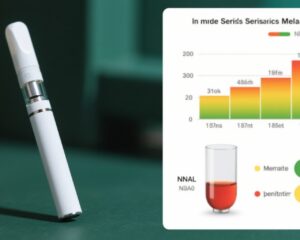Introduction
The phenomenon of dual use, defined as the concurrent use of both combustible cigarettes and electronic cigarettes (e-cigarettes), poses a complex challenge to tobacco harm reduction strategies. While some public health stakeholders consider dual use a transitional phase towards complete smoking cessation, others warn it may sustain nicotine addiction and complicate risk assessments. The critical question centers on whether dual use represents a harm reduction benefit or a perpetuation of tobacco-related health risks. Understanding the patterns and trajectories of dual use in real-time is thus essential to deciphering its true impact on smoking behaviors and health outcomes.
Study Background and Disease Burden
Combustible cigarette smoking remains a leading cause of preventable morbidity and mortality worldwide, contributing to cardiovascular diseases, cancers, and respiratory illnesses. Despite awareness of these risks, many adults who smoke find quitting difficult. E-cigarettes have emerged as alternative nicotine delivery devices with the potential to reduce exposure to toxicants found in cigarette smoke. However, rather than exclusive e-cigarette use or cessation, many smokers adopt dual use behaviors. The health implications of this dual use are not well established, given variable individual trajectories and product use patterns. Hence, rigorous, naturalistic studies are needed to capture real-time behaviors and long-term effects.
Study Design
This analysis was conducted within a large, naturalistic randomized controlled trial based in the United States. Adult smokers were randomized into two groups: one received a one-month supply of tank-style e-cigarettes to use ad libitum (n = 427), and the control group received no e-cigarettes (n = 211). Smoke use was tracked through daily diaries during the sampling period and at 3- and 6-month follow-ups. The present evaluation focused on participants who became dual users within one month (DU; n = 315) versus exclusive combustible cigarette users in the control group (EUCC; n = 182). The primary endpoint was the reduction in cigarettes per day (CPD) as self-reported daily. The study’s naturalistic design allowed observation of user-driven behaviors outside of a clinical intervention framework, enhancing ecological validity.
Key Findings
During the one-month sampling window, dual users reported considerably more diary days characterized by marked smoking reductions — defined as smoking between 1% and 50% of baseline CPD — comprising 23.1% of days, and cigarette-free days accounted for 5.6%. In contrast, exclusive cigarette users had only 6.8% of days with large reductions and 1.4% cigarette-free days, with differences statistically significant (p < .001). At 12 weeks, 18.4% of dual users continued to report smoking 1-50% of baseline CPD, and 9.5% reported abstinence. At 24 weeks, these proportions remained stable at 17.5% and 9.2%, respectively.
Among exclusive cigarette users, significantly fewer participants showed such reductions or abstinence: only 7.1% reported smoking 1-50% of baseline CPD and 1.7% were abstinent at 12 weeks, increasing slightly to 8.2% and 7.1% at 24 weeks.
Within dual users, days when e-cigarettes were used were associated with an 8% likelihood of non-smoking days, significantly greater than the 3% likelihood on days without e-cigarette use (p < .001). This observation suggests a direct temporal relationship between e-cigarette use episodes and reductions or abstinence from combustible cigarettes.
Notably, the study did not report on adverse events or safety parameters in detail; however, dual use was not associated with an increase in combustible cigarette consumption at any time point.
Expert Commentary
This study provides important real-world evidence in support of dual use as a potential harm reduction strategy, with meaningful reductions in combustible cigarette consumption and increases in smoke-free days. Such findings support earlier observational and population-based studies suggesting that e-cigarette initiation may facilitate gradual smoking reduction and cessation for some adults. However, the persistence of dual use underscores the need for ongoing monitoring to ensure that dual users do not become long-term dual consumers, which may sustain nicotine dependence and resultant health risks.
One limitation involves self-reported data, which may be subject to recall or reporting bias, although the use of daily diaries mitigates some concerns through prospective data capture. Additionally, the study’s focus on tank-style e-cigarettes may limit generalizability to other device types. Further, the trial setting involved providing free product samples, which may influence adoption differently than in natural market conditions.
Biologically, substituting combustible cigarette puffs with e-cigarette use reduces exposure to harmful combustion toxicants, theoretically lowering disease risk, although longer-term outcome data are needed to confirm this benefit. The observed temporal association between e-cigarette use days and cigarette abstinence suggests that e-cigarettes can serve as effective nicotine delivery alternatives on a day-to-day basis.
Conclusion
Initiating dual use of e-cigarettes alongside combustible cigarettes demonstrated real-time reductions in cigarette consumption and increased cigarette-free days, compared with persistent exclusive cigarette smoking. These findings add weight to the concept that dual use can be a beneficial intermediate step on the pathway to smoking cessation and harm reduction. Future research should address longer-term health outcomes, characterize user trajectories beyond six months, and evaluate the safety profile to inform clinical guidance and public health policy.
References
Carpenter MJ, Smith TT, Walters KJ, Wahlquist AE, Koval KR, Klemperer EM. Evaluation of Dual Use: Real Time Reductions in Combustible Cigarette Smoking During Co-Occurring Use of E-Cigarettes. Nicotine Tob Res. 2025 Aug 22;27(9):1558-1565. doi: 10.1093/ntr/ntaf055. PMID: 40037836.


